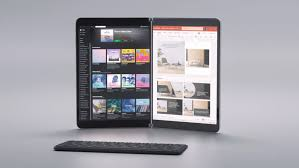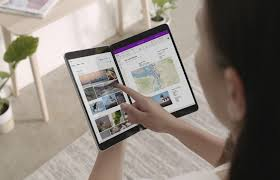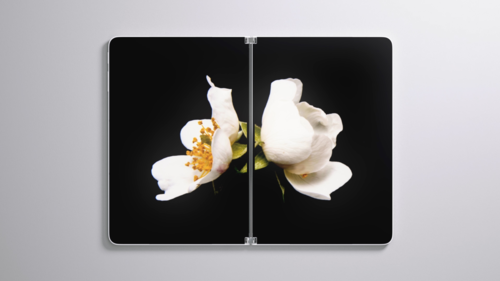In a surprising twist at the Microsoft Event, the Redmond giant unveiled another 2-in-1 hybrid that they’ve been working on. The. It's a dual-screen device that has a tablet-first ethos. With this move, Microsoft essentially now covers the whole gamut of use-cases for personal computers.
It’s a Fresh Design but Not the First to go Dual Screen
It’s generally not a new form-factor. It’s still a clamshell laptop with a hinge that lets you fold the lid all the way around. It’s just that there is a lot more screen real estate here than a lot of other clamshell devices out there because there isn’t any keyboard. Both the lid and the base are 9-inch LCDs that Microsoft claims to be the slimmest ever made. It should spread out to 13.1-inches of screen real estate when you unfold it all the way across. With this much screen, you can work with two full-screen instances of apps at the same time. It could, for example, be used to compare spreadsheet data on one side with a graph visualization on the other.
This unique harmony of software and hardware gives way to new ways to use the device making it truly one of the most versatile gadgets out there. For one thing, you can hold as you would an open book to utilize both screens. Right now, it’s the only device that can be used this way. It can also be used like most other devices with 360-degree hinges.
It's only the second dual-screen 2-in-1 that’s built by a major manufacturer. Lenovo was the first one on this scene with the Lenovo Yoga Book C930. That one, however, has a specific use case with the second screen being an e-Ink display. It was a pretty interesting device that generated some buzz. But it never really matured into a revolutionary gadget. It was a more utilitarian device for artists on the go that still liked to sketch on paper. Typing on the device had to be occasional as the software keys were nowhere near easy or desirable to do.
The Surface Neo is uniquely situated to make this breakthrough. It's made by the very company that designs the operating system. This means that the engineers have full control over the user experience from hardware to software.
Windows 10X
This design gave birth to the Windows 10X. A variation of Windows 10 that’s optimized for dual-screen devices such as the Surface Neo. Who knows, it might even work with the Yoga Book C930.
What it offers is a seamless implementation for any dual-screen device that manufacturers might already be cooking up in their R & D departments. This means that this development isn't only for Microsoft, but other OEMs looking for the next big thing in mobile computing since the tablet as well.
Companies have been betting big on foldable screens. This is pretty evident in the development of the Samsung Galaxy Fold and the Huawei Mate X. Both are smartphone-sized products with foldable OLED displays. They enable you to switch from smartphone to tablet form-factor in the blink of an eye.
But that means it’s only a slight deviation from a tablet.
Microsoft proposes that the increasingly mobile nature of work has given rise to a demand for high-mobility, high-productivity devices. Smartphones generally cut it for some but the increasingly high-volume data that others need to crunch can be difficult on 6 or 7-inch devices. Foldable screens, however, don’t look like they’re up to the task. Other than the limitations of the tablet market not running on iOS, the hardware also doesn’t seem to be ready for primetime. Both the Galaxy Fold and the Mate X have been put on hold at one point in their manufacturing cycles due to some build quality issues.
The Surface Neo’s ample screen real estate and the Windows 10X implementation looks to be the best bet for mobile productivity. Microsoft’s Panos Panay presented great real-world use-case scenarios for the device.
The seamless integration of the peripherals also looks like it’s going to make a huge part of the Windows 10X design. It has a physical keyboard and a brand new pen designed specifically for it.
The Peripherals
When it comes to input methods, software keys are at the bottom of the list when it comes to usability. But it’s available in Windows 10X if you want it. However, I don’t see many people opting for this as there’s an available hardware keyboard for the Surface Neo.
It’s a small keyboard that perfectly fits with the dimensions of the device. It has strong magnets that clip it to back. You just have to flip it onto the screen whenever you need to use it. It looks cramped and, quite frankly, it looks like it’s going to be difficult to use. But we need to remember that Microsoft makes great slim keyboards with the Surface Pro Type Covers and if that’s any indication, at least key travel should be great on these.
There’s also a brand-new stylus pen that Microsoft is debuting with the Surface Neo. If the Surface Pen is any indication of how this stylus would work with the Surface Neo, then we can probably expect great performance out of it.
Right now, it’s not entirely clear of the Surface Neo would ship with these peripherals. But if we’re to look at how they still refuse to do that with the Surface Pro’s Type Cover, there’s very little reason to hope for that scenario. We’re betting that they’ll also come as additional purchases.
2020 Release Date
They’re not releasing it any time soon though. They’ve slated it for December of next year. This announcement merely lets developers see how they can design apps that will make use of this new design.



